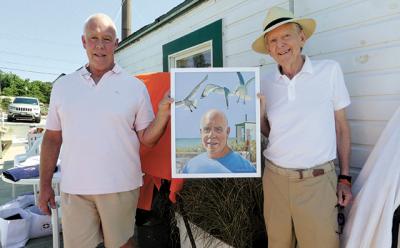Tentative Increase Is Below the Cap
Tentative Increase Is Below the Cap

Tentative budget numbers released last Thursday by East Hampton Town Supervisor Larry Cantwell call for $73.5 million in town spending next year, up from $71.5 million. The proposed $2 million, or 2.76-percent, increase will be offset in part by $910,000 in savings, reducing the amount to be raised by taxes and keeping it below the New York State mandated 2-percent cap.
“The 2016 budget increases enforcement personnel and our ability to enforce the law and codes throughout the community,” Mr. Cantwell said in a press release. That, Mr. Cantwell said, “will allow the town to more effectively identify and prosecute abuses, reduce the occurrences of violations by increased presence, and refine the adopted codes and ordinances with strong new legislation.”
The total amount to be raised by taxes would increase by $176,732 or 1.8 percent. Because assessed values have increased, however, tax rates would rise by 1.67 percent for the majority of residents, to $29.38 per $100 of assessed value. For those with a house valued at $1 million, that would equal $34.
Tax rates would increase by only .48 percent for those who live within East Hampton or Sag Harbor Villages, with a $4 increase estimated for those with million-dollar houses, and the proposed tax rate at $11.69 per $100.
While the board “made great strides” this year toward that goal, the supervisor said, the tentative budget for next year “funds permanent staffing to ensure we continue this positive momentum.” In addition, the supervisor said the tentative budget addresses “planning needs for infrastructure improvements.” Meanwhile, he said, the budget maintains “strong financial and budgetary controls that have resulted in the town achieving its highest credit rating in nearly 10 years.”
If adopted as proposed, one fire marshal, one code enforcement officer, and three additional police officers would be hired. Along with positions filled this year, including a new assistant town attorney and a new building inspector, salaries and benefits would come to $625,000.
These positions, Mr. Cantwell said in his budget message, “will improve the town’s ability to identify violations, enforce the codes, prosecute offenders, and draft new legislation.” The hires will bring the number of Ordinance Enforcement Department officers to 7, and police officers to 65.
The budget adds two seasonal Parks Department workers to expand summer garbage and litter programs, as well as $825,000 for part-time seasonal help and overtime costs in the Marine Patrol and Police Departments.
Mr. Cantwell’s budget would make use of just over $1 million from surplus funds and reserves. At present, all of the town’s major funds, except for the scavenger waste fund, are in the black, with surpluses ranging from 21 to 34 percent. At the close of 2016, increases in most of those surplus amounts are anticipated, except for the highway and airport funds, with the latter expected to decrease by 2 percent. The $322,271 deficit in the scavenger waste fund this year would go down by $100,000, to $222,271, under the tentative budget.
Overall town indebtedness is projected to decline, from $104 million to $98 million, under the tentative budget. In recent years, the town has reduced its debt payments by keeping new debt — borrowing for capital projects — below the amount that is being paid off each year. That policy, as well as refinancing existing debt to take advantage of lower interest rates, will achieve a $315,000 savings next year.A reduction in mandated state retirement system contributions will save the town $580,000, and closing the scavenger waste processing plant and transfer facility will save $15,000.
If the budget is approved, the budget in the airport fund would increase next year by over 22 percent, to $5.9 million. Just over $1 million is allocated on the “outside professional” line, up from $270,000 this year. Litigation as a result of the town’s attempts to reduce airport noise is ongoing, and lawyers’ fees would be on this line.
Also included in the budget is $50,000 for engineering for infrastructure improvements, $22,000 to upgrade the town website, and $155,000 for water quality monitoring and improvements.
Outside cultural, educational, and human services groups that would receive funding under the proposed budget include Phoenix House, with $50,000 for its substance abuse counseling. The South Fork Health Initiative, which focuses on mental health, would receive $25,000, and the Retreat, a domestic violence services agency, $5,000.
Funding for children’s services at the Eleanor Whitmore Early Childhood Center is budgeted at $80,000, Project Most, the after-school program, at $35,000, the Montauk Youth program, at $5,000, and the Pediatric Dental Fund, at $2,500.
The East End Disabilities Group would receive $5,000, the East End Special Players, $10,000, and the East Hampton Historical Society, $20,000, earmarked for Second House in Montauk.
The town board will review the budget and discuss suggested changes. A preliminary budget will be the subject of a hearing that, according to state law, must be held before Nov. 15. The budget for next year must be adopted by Nov. 20.









